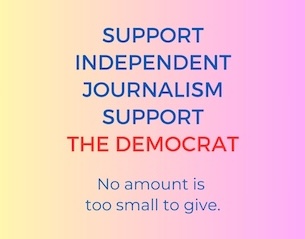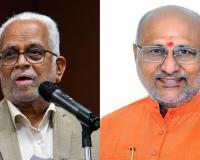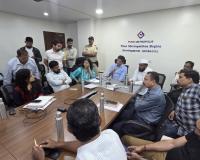- India
- Renowned stalwart of media and communication research discussing novel ideas
Renowned stalwart of media and communication research discussing novel ideas
Dr. Sharmila Kayal Kolkata : Prof. Janet Wasko an eminent Professor of Media Studies, University of Oregon, US, Author and co Editor of 22 books and also a former President of IAMCR, discussed ideas and deliberated on novel concepts on the second day of IAMCR (International Association of Media and Communication Research) India webinar series on

Dr. Sharmila Kayal
Kolkata : Prof. Janet Wasko an eminent Professor of Media Studies, University of Oregon, US, Author and co Editor of 22 books and also a former President of IAMCR, discussed ideas and deliberated on novel concepts on the second day of IAMCR (International Association of Media and Communication Research) India webinar series on Media and Communication Research, organized by the Kolkata-based Adamas University, School of Media, Communication and Fashion.
The international webinar is being organized in association with the Media Partners- ABP Education, IndiaReal and The Policy Times. The international India webinar series is being organized over a period of 5 days from August 3, 2020 to August 7, 2020.
The joint convenors of this international webinars are Prof. Ujjwal Kumar Chowdhury and Dr. Uma Shankar Pandey (IAMCR, Ambassador, India). The second day session was chaired by Prof. Ruchi Kher Jaggi, Director, Symbiosis Institute of Media & Communication. The concluding comments were drawn by Dr. Pradeep Mallik, HOD, School of Liberal Studies, PDPU, Gujarat.
Prof. Janet Wasko started by giving warm greetings to all. The topic of the day was “Investigating Global Media Giants –Case study –Walt Disney Co.” Her Discussion included research related to global media corporations and an overview of the issue of different kind of methods to teach, to study, to research in any media corporations especially media corporations. She exclaimed that the process of doing corporate research is a lot of work in comparison to other research. Her approach was “Critical Study of Political Economy of Media/Communication”. The common definition of political economy provided by Vincent Mosco is “Political economy is the study of social relations, particularly the power relations, particularly the power relations, that mutually constitute the production, distribution, and consumption of resources, including communication resources”. She underscored the power relations and resources as they are very key notions in the study of political economy. Dallas Smyth in 50’s described the study of political economy of communication as structure and policies of media and communication institutions in their social settings. She further explained that although there are variety of institutions that are involved with media and communication only a few media corporations dominate the media of the world. So according to her it is important to study these corporations. She explained the components of “Studying Corporations” as (a) In a holistic way, (b) Integrated with other kind of approaches, (c) It has to be interdisciplinary, (d) It has to be done regarding the corporations as a part of a system so to look into it in a boarder way. She suggested to expand the study as “Critical Political Economy Plus” as it is not just political it is not just economy it is more broad and it includes other related issues and other kind of approaches for understanding the media. She mentioned the book “Global Media Giants” a collection of various studies of media corporations around the world edited with Benjamin Brikenbein and Rodrigo Gomez about media corporations and ways they dominate in some regions of the world. She highlighted about three profiles which include the economic profile, political profile, cultural profile. In cultural profile key points which include financial data and market share, corporate structure and properties, typical strategies, new developments. Political profile consists of ownership, ties to the state and lobbying efforts, board of directors and interlocks, labour. Cultural profile includes symbolic universe and ideology, popular products/ services and everyday life, cultural imports/ exports to /from other countries. The book covers a number of different companies around the world not exclusively global media giants but includes regional and geo linguistic giants in certain parts of the world. And further it also includes overviews for different regions around the world to look at strong companies and corporations that dominate.
She then described the methodological approaches used to study the political economy of media/communication. There are a lot of different approaches to this kind of studies she exclaimed. She mentioned two “General approaches to study Corporations” i.e. “Power Structure Research and Social Network Analysis”. The definition of power structure research given by Bill Plympton as “Power structure research is an approach to the study of power that highlights the unequal distribution of resources upon which power is based (e.g., wealth, political office, control of the mass media) and the importance of formal and informal social networks as the means by which power is concentrated and institutionalized”. She further stated that the root of power structure research is in 60’s and 70’s in America. According to her the study of political economy emerged a kind of term in the 20th century with muckraking activities in the US. It involves Marxist ideas. More recently it evolved and expanded to not only encompassing just issue of class but involving analysis of race, class and gender woven together.
She then moved on to explain Social Network Analysis. It has been described in many ways but according to her it boils down to structure of relationships using “nodes”(also called verticals)and “edges”(also called ties),. Observational units such as organizations, Individuals, web pages, or even brain cells are nodes of a network; their relationships to each other, whether contracts, friendships, hyperlinks, or synapses, are its edges. The nodes and edges of SNA lend themselves naturally to data visualization. Indeed, static and interactive plots of the “web” of relationships in a network are among SNA’s most popular and useful features-she further iterated.
She went on to explain corporate research methods which includes document analysis, interview, participant observations, ethnography. Apart from document analysis other methods are bit problematic as stated by Wasko. She explained that the document analysis source can be many by giving examples of manuscripts, letter and dairies, public records, autobiographies, publications etc. For document research a researcher faces the following issues (a) Access and (b) Authorship. For document research access to documents is needed and also who produced the document is also important. She further explained about the techniques used for the research such as quantitative and qualitative techniques. Quantitative technique includes content analysis , social network analysis etc while qualitative techniques includes grounded theory, qualitative content analysis, interpretive analysis, etc. She went on to explain these techniques. From John Scott’s book “A Matter of Record” she listed 4 criteria for documentary research, 1. Authenticity-who is the real author of a document, is it forged, is it written for promotions etc, 2. Credibility- to evaluate the credibility of the document vis-à-vis its author, 3. Representativeness- How representative is the document, 4.Meaning- to understand the meaning of the document, context of the document.
She then moved into areas of interest in investigating corporations which includes properties, financial status, stock ownership, board of directors, bank relationship, lawsuit/legal relationship, labour/trade union relationships, relationship with other companies.
She talked about Walt Disney Company as a case study. She explained it through her book “Understanding Disney”. In this book she not only described about the corporation and in the book she has covered history of the company, financial holdings, organizational structure as well as Disney universe, what they produce, how they produce, who consumes it etc. She further gave overview of all the above subjects. She concluded by saying that Disney is not inevitable. It may not go forever. As the challenges are mounting in recent times Disney may fade despite of recent successes.
ooo













